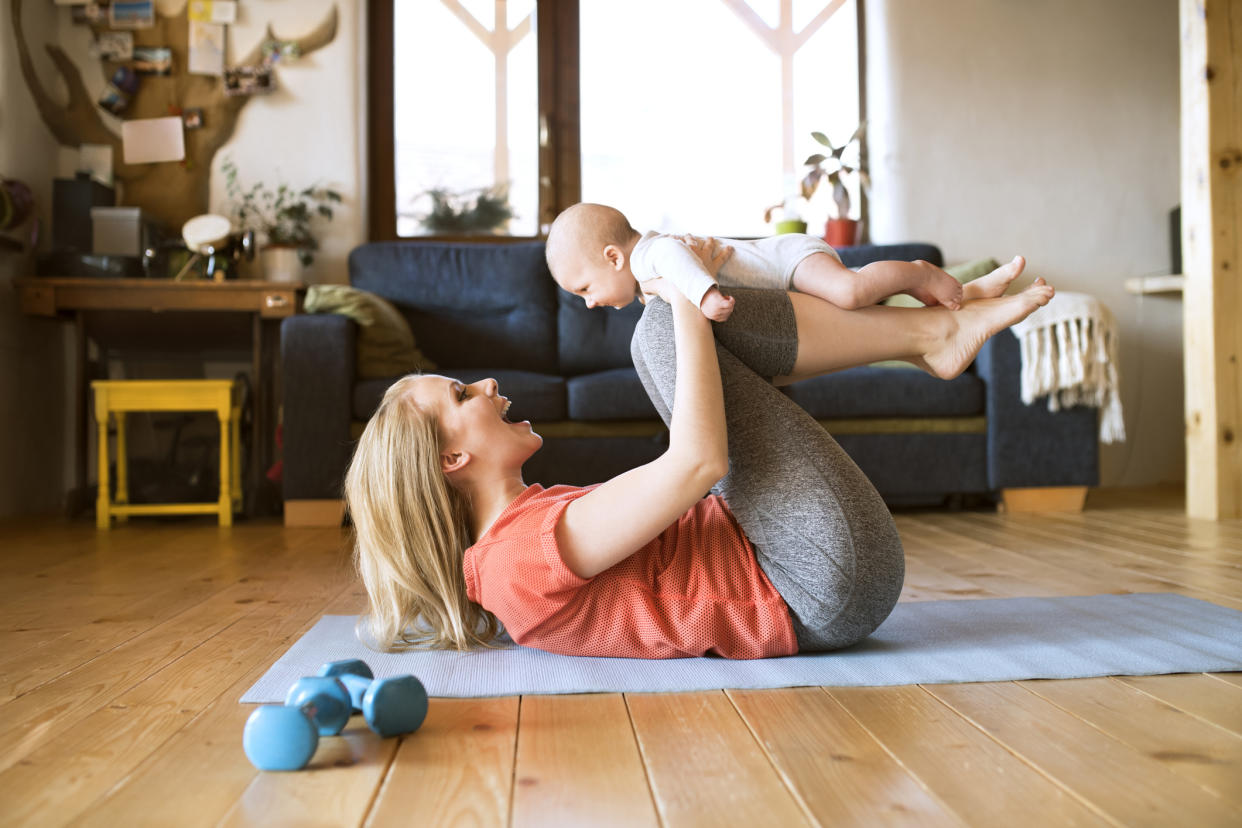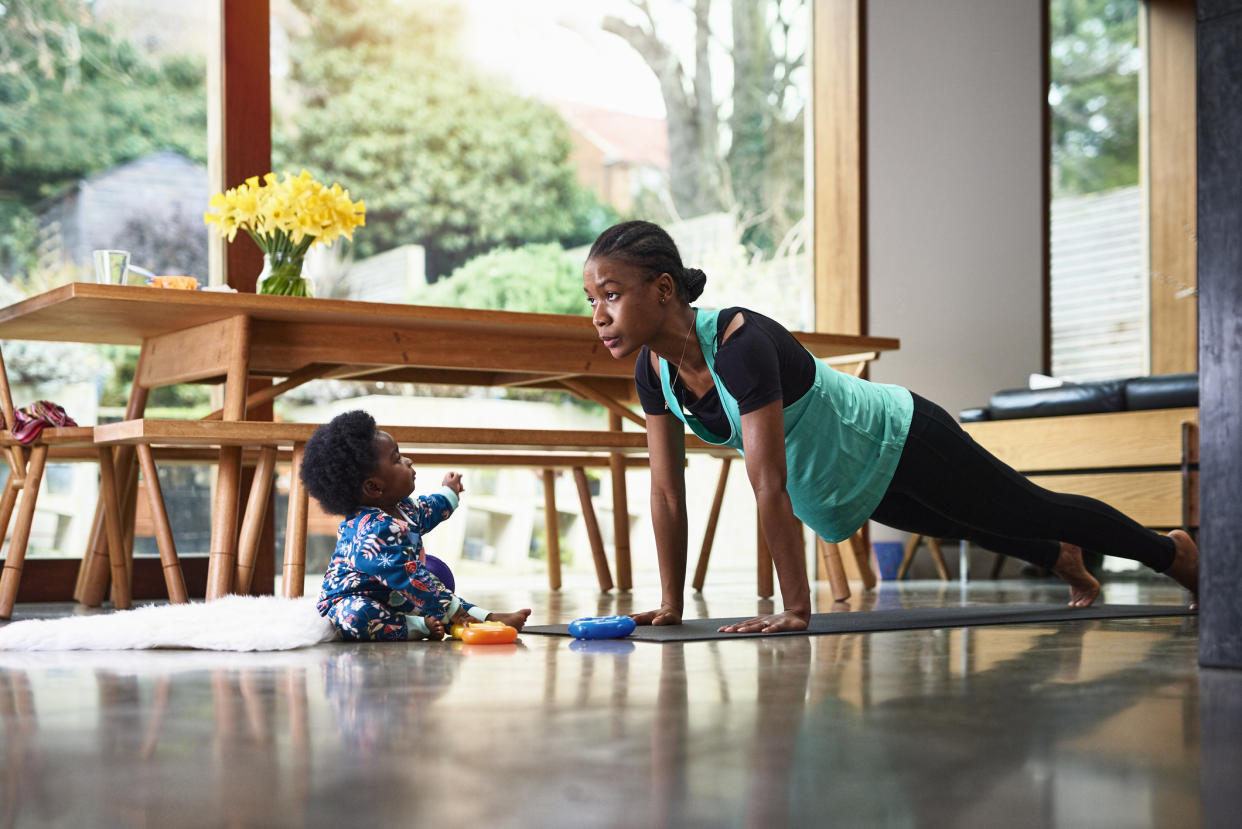How to exercise safely after giving birth as Joe Wicks sparks debate

Joe Wicks has sparked a debate online about the pressures of getting into shape post birth after sharing videos to Instagram of his wife's postpartum workout routine.
One video shows the new mum, who recently gave birth to the couple's fourth child, doing weights, with writing on-screen revealing: "strength training with Rosie 10 weeks postpartum slow controlled movements."
Another shows Rosie doing pull ups with the writing "upper body strength with Rosie" and a third says "lower body strength workout with Rosie."
After sharing the workout videos many fans praised the personal trainer and his wife for helping to inspire others with the post natal exercise content.
"Way to go Rosie," one wrote. "You look incredible to say you’ve had 4 children and not long giving birth. Keep inspiring us to keep moving and motivated."
"So refreshing to see these videos as a new mama myself back at the gym and training hard," another agreed.
But some of the personal trainer's followers pointed out they felt it could depict unrealistic fitness goals for other new mums.
"A quick reminder to all those postpartum women who are nowhere near this and are just about making it through the day… you are just as incredible!" one user wrote. "This is fantastic if it’s right for you, but it’s not a benchmark for comparison."
"This is amazing but I hope a lot of new mums realise that Rosie was incredibly strong pre-her-pregnancy and was doing this kind of training in her pregnancy," another commented. "She is a seasoned pro at these exercises so will be able to feel if her body is coping with them.
"It's good to see but I also think @thebodycoach you both have a responsibility to set the picture as a lots of new mums are incredibly vulnerable at this point post pregnancy."
Another added: "I mean this is great for you but other women who have had a baby don’t have the privilege of an at home top of the range gym you guys are smashing it too!!
"Not everyone who has had a new baby has a supportive husband or personal pt, home gym some women are just making it through the day so if you can’t do this – walking with the pram with your baby is just as good. I’m sure Rosie knows she looks amazing and other mums you do too regardless of size or shape."

How to exercise safely postpartum
From learning to listen to your body to figuring out how to exercise around your newborn going back to exercise after childbirth can be a daunting experience.
According to the NHS, if you have had a straightforward birth, you can resume "gentle exercise as soon as you feel up to it", like walking and stretching.
However, they advise: "It's usually a good idea to wait until after your six-week postnatal check before you start any high-impact exercise, such as aerobics or running."
If you do feel up to starting exercising again, Mari-Carmen Sanchez-Morris, a women’s health and fitness expert specialising in pre and postnatal health, and founder of FIT MAMA, says it is important to listen to your body and start of slowly, gradually increasing intensity as time goes on.
"Remember, every woman's recovery is different, and what feels right for one new mum might not be suitable for another," she adds.
Following a C-section, the recovery period is longer due to the major abdominal surgery involved.
"I recommend waiting at least six weeks before starting any exercise and getting clearance from your health visitor," she continues. "Rushing a return to exercise can hinder your long-term healing process and increase the risk of complications.”
Sanchez-Morris says complications during pregnancy or birth, such as tearing, episiotomy, or infections, can extend recovery time.
"Additionally, breastfeeding can impact energy levels and hormone fluctuations, which may affect your readiness to exercise,” she adds.
Tips for getting back into exercise after giving birth
Find what works for you
Women's fitness specialist Federica Gianni recommends starting slowly and focussing on rebuilding strength from the inside out.
Pelvic floor exercises (like Kegels) are key to rebuilding core stability.
Gentle walking is a great way to ease into cardiovascular fitness.
Postnatal yoga or stretching routines help with flexibility, relaxation, and regaining range of motion.
Bodyweight exercises (like glute bridges or modified planks) will help regain core and overall body strength. Avoid high-impact activities, running, or heavy lifting in the first weeks postpartum.
Make sure your body is ready
Gianni says your body will give signs when it's ready to begin exercising. She suggests looking out for:
Energy levels starting to return.
Stitches or incisions (if you had a C-section or perineal tear) are fully healed and pain-free.
No symptoms of pelvic pain, incontinence, or diastasis recti (abdominal separation).
Feeling emotionally ready to engage in physical activity, as mental readiness is equally important. Always consult with a healthcare provider if you’re unsure.
"It's highly recommended to get the all-clear from your GP, midwife, or obstetrician before returning to exercise," Gianni adds.

Remember every new mum is different
If you were fit and active before or during pregnancy, you might be able to return to exercise a little sooner, but it’s still important to take it slowly.
"Fitness levels pre-pregnancy can aid recovery, but the body still goes through significant changes during childbirth," Gianni adds.
If you weren’t very active before or during pregnancy, it's essential to ease into exercise even more gradually.
"Focus on gentle movements and give your body time to adjust to this new routine," Gianni suggests.
"Regardless of prior fitness levels, postpartum exercise should prioritise healing and rebuilding strength over pushing for intensity too quickly."
Listen to your body
When or if you do choose to start exercising Gianni says it is important to listen to your body. "Pay attention to discomfort, pain, or any unusual symptoms," she advises. "If you feel pain, dizziness, or extreme fatigue, it’s a sign to slow down or stop."
Hydrate and fuel your body
Don't forget your body needs plenty of hydration and nutrients, especially if you’re breastfeeding.
“Prioritising a healthy diet packed with whole foods fuels your body for optimal recovery and caring for your newborn, and yourself," Sanchez-Morris adds.
"Fill your plate with colourful fruits and vegetables, lean protein sources like chicken or fish, and fibre-rich whole grains. These choices not only support your energy levels but also indirectly support your baby if you are breastfeeding.”
Be patient with progress
Postpartum bodies take time to rebuild strength and resilience. "Celebrate small milestones and avoid comparing yourself to others," Gianni adds.
Health and wellness: Read more
Foods you should stop putting in kids’ packed lunches (Yahoo Life UK, 4-min read)
'Postpartum psychosis made me believe I was in a real life Squid Game' (Yahoo Life UK, 6-min read)
Does excess sweating cause hair loss? (Yahoo Life UK, 6-min read)


